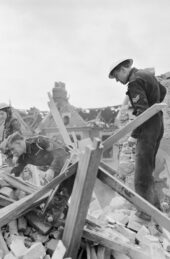I write crime thrillers set in World War Two London. My hero is Frank Merlin, a tough and rugged police detective heading a Scotland Yard serious crimes unit. There are now five books so far in the series. It is my plan to follow Merlin’s adventures from beginning to end of the war. The first book, The Embassy Murders, is set in January 1940. In the Shadows of the Blitz, the second, in September 1940. The action in the third book, The French Spy, takes place in June 1941, and that in the recently published fourth, A Death in Mayfair, in December 1941. The latest, Dead in the Water, is set in August 1942. At the current pacing of stories, you can see that I’ll need four or five more books to get my policeman to Victory in Europe Day in 1945.
The VE Day celebrations this month have brought the spotlight again onto those tumultuous wartime years. I have always been fascinated by the period, which was why I chose it as the setting for my detective stories. Most of the action in my books takes place on the British Home Front, although there are brief storyline excursions to places like Paris, Berlin, Warsaw, Moscow, New York, Buenos Aires and Cairo. London, however, is the centre of Merlin’s world and its crimes the focus of his determined attention.
It is still not widely appreciated that crime boomed during the war. Criminals had a field day. When the war ended it was a source of regret to many on the wrong side of the law. One notorious crook went on record in later life saying that the war was a golden time for him and he’d never forgive Hitler for surrendering.
There were a number of contributory factors to the crime boom. Blackout regulations proscribed all types of night lighting. Street lamps were dark and households had to use heavy blackout curtains to prevent domestic lighting from escaping. Criminals took full advantage of the darkened streets. A young airman called Cummins became known as the ‘Blackout Ripper’ after he mutilated and murdered several young women in the West End of London in the winter of 1942.

Gordon Cummins
Another factor was the chaos caused by German bombing. Police and the auxiliary services had their hands full dealing with the vast destruction caused by the Blitz. Over two million British houses were destroyed, a third of them in London. Looting was rife and all sorts of ordinary people got involved, not just the criminal classes. In December 1940, when the London Blitz was at its height, the courts at the Old Bailey tried over 4,500 looting cases.
The introduction of rationing provided a whole new world of potential criminal activity. Food, petrol and clothing were the principal restricted items and the Government managed the process through a system of ration books and coupons. Such books and coupons could be forged or stolen, and they were, on a massive scale. At the same time a black market in rationed goods came into being and expanded rapidly. Much of the illegal activity was carried out by powerful London gangs which operated throughout the war. The head of the biggest, Billy Hill, proclaimed himself the ‘King of the Black Market’.
The London gangs didn’t confine their activities to the black market. There were plenty of other easy pickings in the London ruins. Hill’s gang carried out numerous smash and grab raids on some of London’s finer shops. Protection rackets continued as always and there were other newer opportunities to exploit. For example, military stores were a treasure house of valuable commodities. With a well-placed bribe or two, these could be easily plundered.
The vice business was another which flourished during the war. The shady side of London nightlife swiftly proved a magnet to the growing numbers of men in uniform. As these numbers advanced, so did demand. By 1944 there were over 4.5 million troops stationed in the country, 3 million British and 1.5 million American, and prostitution had become a massive business. The leading London vice gang was run by a Maltese family called the Messinas. The huge band of girls they ran were known as the ‘Piccadilly Commandos’.
All of the above-mentioned criminal activities have found there way in some form or other into the Merlin books. There’ll be more murder and robbery in my new book, the fifth in the series, along with art theft, espionage and racist violence in the American army. It will be published next year.
Mark Ellis is the bestselling author of the DCI Merlin series, the latest of which is Dead in the Water.
This article first appeared on the Trip Fiction website.







